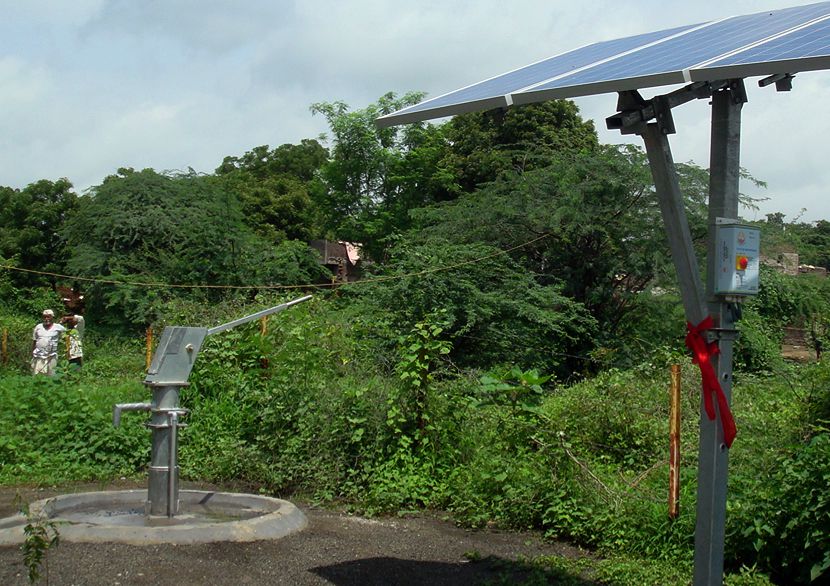In the search for clean drinking water, scientists and engineers have cycled through filtration, chlorination, oxidation and just about any “-ation” one can think of. Despite these previous efforts, a paper written by researchers at Massachusetts Institute of Technology presents a more economical and innovative approach: photovoltaic-powered electrodialysis — or more simply, the process of removing salt from water via an electronic system that runs on solar power.

The research was funded by Jain Irrigation, Inc. and focused on making the salty groundwater of India drinkable, an endeavor that could yield massive effects on the country’s villages. India has “nearly 600,000 villages that collectively house 800 million people, 11 percent of whom do not have access to an improved water source,” stated the paper, which was published Aug. 30 in the online issue of the international science journal “Desalination” and will be featured in their November issue.
Although the method may sound complicated, the researchers behind it seemed to indicate this usage of solar panels to purify water is anything but. Natasha Wright, first author of the study and a doctoral candidate at MIT, said the key goal of the paper was to present a method that would be simple and economically sustainable.
“If the systems are so expensive that they have to be donated entirely, that’s not sustainable for the village or for the organization that’s doing the donation,” she said. “We kind of started from ground one.”
In order to strike this balance between economic accessibility and scientific modeling, Wright has been visiting India every January and August since 2012, and she plans on continuing to do so.
“The goal of the trips is really to engage all of the stakeholders along any sort of product line,” she said. “So that’s anywhere from the percent of the village that is going to be using this eventually, all the way through manufacturers, distributors, small NPOs [nonprofit organizations], big water NPOs.”
Between the visits, Wright and Amos G. Winter, the second author of the paper and an assistant professor in the Department of Mechanical Engineering at MIT, carried out the technical research that eventually developed into the solar-powered electrodialysis model.
The model somewhat emulates the electrodialysis diagrams that appear in college-level chemistry textbooks. An anode and a cathode sit parallel to one another as water runs between the two. When the water contains ions — or in this case, salt — a solar-powered current pushes the positive ions one way while negative ions go the other.
“So what that does is it pulls ions out of the water, so you’re left with clean, pure water in the middle,” Wright said.
The system also contains a line of “ion-selective membranes,” between the anode and the cathode, Wright said. These alternate between cation and anion exchange membranes that pull salt toward the sides, trapping it.
“So you might have a hundred of these cell pairs in a step,” Wright said. “So you would have 50 channels of clean water and 50 channels of salty or brine water in the end.”
Apart from the simplistic design, the electrodialysis also runs on solar power, a plus in an increasingly energy conscious world, said Dr. James Baldwin, a visiting assistant professor in the Department of Earth and Environment at Boston University.

“The simplest benefit is that it’s renewable energy,” he said. “So as long as the solar system exists, it’s a technology that we can use.”
The cost of solar energy is also a benefit. Solar modules have been declining in cost for the past 20 years, Baldwin said, and that trend is not stopping anytime soon.
“The economics of solar are only getting better and better…A 50 percent cost reduction in the 1990s is crazy. That’s very impressive,” he said. “There are very few other technologies, especially energy technologies, where you see costs fall that quickly.”
But the search for fresh water does not always require scientific tools. BU’s Global Water Brigades, a student organization that travels to Honduras to develop various clean water delivery systems, stands as proof.
“We’re working alongside the community. We’re not doing anything for them. We’re doing everything with them,” said Ron Glandian, secretary of BU Global Water Brigades and a senior in the College of Arts and Sciences. “Most of the piping works mainly as a gravity system, so no energy, none of that.”
Similar to the MIT researchers, GWB’s main goal is sustainability and even though the group doesn’t use energy for water purification, Glandian said they have a strong track record.
“I don’t think Water Brigades has ever had to return to a previous site because something didn’t work,” he said.
Wright and Winter, on the other hand, plan on visiting their sites many more times. In fact, their first experimental model will go up in India in January.
“There’s always still going to be some elements of charity, but the goal in the end is to create a system that is economically sustainable enough that it doesn’t need to be a charitable thing in that way,” Wright said. “One of the best ways that we can make it expand faster is if it’s economical to begin with.”
























































































































Augusto Farro • Jun 28, 2016 at 2:35 pm
Dear Becca, Natasha,
I would like to introduce myself, I am professor of the University Centro Occidental of Venezuela and South Scientific University of Peru (UCS).
The objective of this letter is to let you know that I have been trying to contact Dr. Winter, with the objective to make a proposal to develop a desalination Project of sea water and salty waters, similar to what you have done in India.
The letter to Dr. Winter was sent around two weeks ago and as I have not yet received a reply I would like to know if you could facilitate the communication with Dr. Winter if appropriate.
Looking forward to hearing from you,
Best Regards,
Dr. Augusto Farro